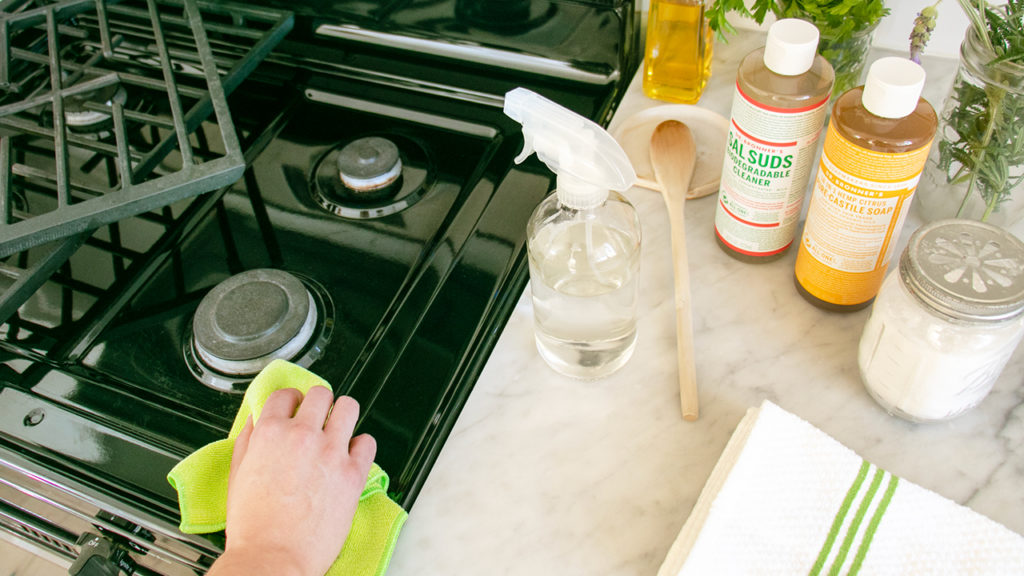
A dirty oven and stovetop is a sign of a used oven and stovetop, and that is a good thing. I’m thrilled people are cooking. What I’m not thrilled with is the unnecessary intensity of store-bought stovetop and oven cleaners. The task certainly needs to be done regularly and I’m glad to share with you my best—and oft used—tips and tricks for how to clean an oven and stovetop safely and simply.
It’s inevitably right when I need to use the oven that I realize how cruddy it’s gotten. Like when guests are coming in the door, and I thought I’d greet them with the delicious smells of baking cookies. Instead there’s an undeniable cloud of last night’s salmon wafting through the house because I forgot about the broiling spatters.
It doesn’t help that cleaning an oven ranks low on my list of enjoyable housecleaning tasks. I’d rather do laundry than tackle the spills and overflows from the dinners of ages past. Manufacturers of cleaning products seem to know this because they have made all manner of oven cleaners that promise ease and sparkle with next to zero input from me.
And that is the red flag.
Whenever a product promises to do some tough job all by itself, it likely contains intense compounds that pose unjustifiable risk. These compounds may do the promised job, but often at the cost of emitting hazardous fumes, especially with bleach-based cleaners, which could impact not only the person doing the cleaning, but anyone or pet in the house. Also, these substances cause downstream pollution when they’re rinsed away, either into sewer or septic systems. Wastewater treatment eliminates biological contaminants but are not capable of removing nonbiodegradable chemical compounds. Furthermore, since these cleaners are designed to eat through whatever organic material they contact, the damage caused by accidental contact or ingestion can be irrecoverable.
When something sounds too good to be true, it usually is. Oven cleaner and drain cleaner are the two conventional products I urge households to eliminate right away. They are not worth it.
Instead, I have a range of easy oven cleaning options for you which use some of my favorite green cleaners: heat, lemons, vinegar, baking soda, and of course Dr. Bronner’s Sal Suds and Pure-Castile Magic Soaps. Pick your favorite.
But first you’ll need…
My GIY All-Purpose Cleaning Spray with Dr. Bronner’s
“GIY” stands for Green-It-Yourself, and this is the first dilution I encourage people to make with their bottles of Dr. Bronner’s Sal Suds or Pure-Castile Magic Soap. I keep several bottles around the house in handy spots. One lives under the kitchen sink. You can click over to the full article about this versatile spray, or here’s the quick recipe:
GIY All-Purpose Cleaning Spray
- 1 qt. (1 L) water
- ¼ c. (60 mL) Dr. Bronner’s Castile Magic Soap (any scent) OR 1 Tbsp. (15 mL) Sal Suds Household Cleaner
- 20 drops tea tree essential oil (optional)
Cleaning an oven with nontoxic cleaners
First, remove any loose matter: crumbs or tidbits or loose ash. You can brush it out with a hand broom or even use your vacuum hose.
Second, remove the oven racks and wash them separately with Sal Suds or the Pure-Castile Magic Soap either in your kitchen sink, if it’s large enough, or in a utility sink, or even a bathtub.
Then, you pick what comes next:
Option 1: Activate the self-cleaning feature
The self-cleaning setting on an oven has some pros and cons. The biggest pro is that it’s undeniably convenient: a clean oven at the press of a button or the turn of a knob. Plus, this method does not use any harsh chemicals.
On the downside, a self-clean cycle uses a lot of energy to get up to the 600+ degrees and maintain it for several hours. Furthermore, it can emit acrid fumes that could pose problems for anyone with respiratory ailments and for sensitive pets such as birds.
If you use your oven’s self-cleaning feature, turn on the range hood or whole-house fan or open windows.
After the cycle is complete and the oven is cool, wipe out the ash with a damp cloth.
Option 2: Steam crud away with lemons or vinegar
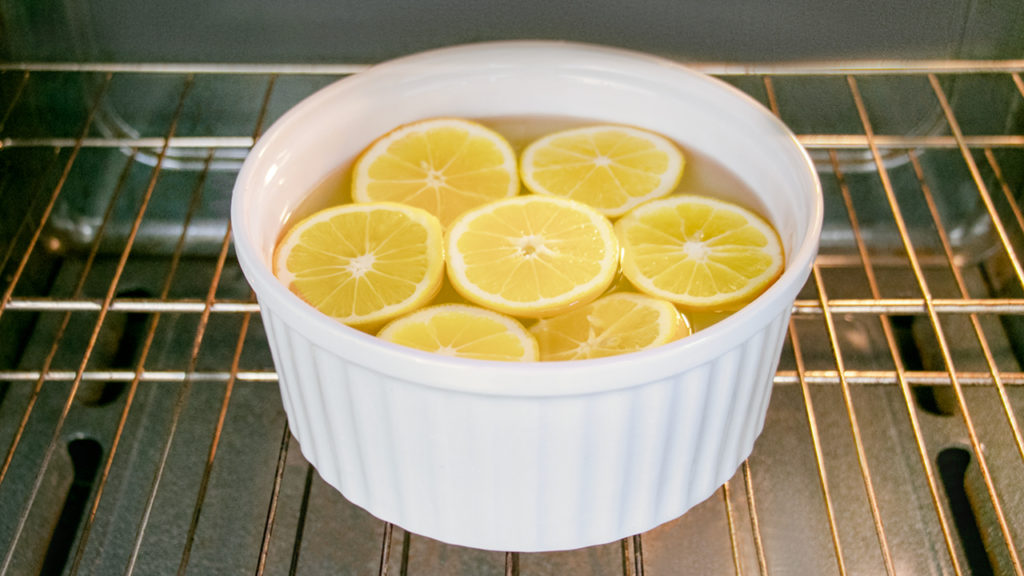
This method using the lemon steam is my favorite. It makes the house smell fantastic! The oven stays off for this method, or else it will vent out all the lovely steam.
Supplies: Lemons and a pot with a lid that can go from stovetop to oven (or microwave to oven if you prefer).
Remove all but one oven rack.
Fill a four-quart stove pot with quartered lemons and 1 cup of water. Cover the pot and heat the contents on the stove to simmer. Allow it to simmer, covered, for 15 minutes or so until the lemons are soft. Keep the lid on. Transfer the pot to the oven, remove the lid, and immediately shut the oven door.
Keep the oven closed for at least one hour. Then open the oven and immediately wipe off loosened crud with a damp cloth. If it needs a little more action, use my All-Purpose Spray with a wipe. You can also use a plastic scraper to lift softened grime. Be sure to keep the scraper at a near horizontal angle so as not to scratch the surface.
Vinegar alternative: If you don’t have lemons, fill the pot with equal amounts vinegar and water. Bring it to a steady simmer while covered. Then transfer it to the oven, remove the lid, and shut the oven.
Microwave alternative: Use a microwave-safe, oven-safe casserole dish. Fill with the lemons or vinegar and bring to a steady simmer. Then carefully transfer it to the oven, remove the lid, and shut the oven.
Option 3: Apply a baking soda paste and wait
This trick does not work at the last minute, but if you can remember to get this going ahead of time, it takes very little input from you.
Supplies: Baking soda, water, and time!
For the remaining stubborn burned spots, or if your oven is generally clean and only has some stubborn burns, make a paste out of baking soda and water. Add just enough water to the baking soda to make a spreadable paste, mixing it with a fork to break up the lumps. Spread this on the burned spots. Let it sit overnight. Yep, overnight, or as long as you can. Time is your helper here.
In the morning, scrape off the paste with a plastic scraper (used at a low angle so as not to scratch) and throw the paste in the trash. Use the All-Purpose Spray to wipe off any remaining spots.
Cleaning the stovetop
Oh, have I ever had my share of stovetop messes. Splattered apple butter, overflowing sauces (I just turned my back for one second!), spitting stir-fries. They have given me lots of practice in cleaning not only the stove, but also the knobs, the grates, and the heating elements. Sigh.
Here’s one tip I’ve recently realized: Don’t serve food from the stove! Rather move everything to the counter, because the counter is so much easier to clean!
Supplies for cleaning stovetops: All-Purpose Spray, several damp and dry cloths, hot water, time.
As with grime anywhere, the sooner you tackle cleaning it, the easier the task.
First off, wait until the stovetop has cooled to a touchable temperature, but still slightly warm. Wipe off any loose material.
For simple grease splatters and smudges, give them a spray with the All-Purpose Cleaning Spray and wipe with a damp cloth. For the best finish, dry the surface with a dry soft cloth. I find that microfiber does the best job.
For stubborn burned-on grime, there is one cleaner that is my go-to regardless of what the cooktop is made of or what caused the mess: hot water.
Lay a washcloth over the grime and pour very hot water (don’t scald yourself) on the cloth until it is saturated. Let the cloth sit there about ten minutes or until cool, and then wipe up.
For remaining burned spots, apply the baking soda paste from the oven cleaning. Let it sit for 15 minutes for small spots or as long as overnight for super stubborn spots. Wipe off with a damp cloth.
Follow up with the All-Purpose Spray and wipe with a damp cloth.
Ceramic glass or enamel stovetops
In addition to the tactics above, manufacturers recommend using a plastic scraper at a near horizontal angle to lift up any hardened spills. Take care not to scratch the surface.
For a final polish of your clean stovetop, spray surface with my GIY Glass Cleaner, which is a 1:1 combination of distilled white vinegar and water. Wipe with a dry, soft microfiber cloth.
Brushed stainless steel stovetops
For the best finish, wipe the surface in the direction of the grain.
Porcelain stovetops
Porcelain is particularly sensitive to acid, so if you spill tomato sauce or lemon juice on your cooktop, be sure to clean it up promptly.
Knobs, grates, and heating elements
The All-Purpose Spray does wonders on knobs, grates, and heating elements. However, if they need a bit more action, try the hot water trick with them, too. Grates can benefit from a good scrub in a sink of Sal Suds or Castile Magic Soap and hot (not scalding) water. Some are even designed to be cleanable in a dishwasher – check your manufacturer’s recommendations on that first.
What not to use on your stovetop
As you may have noticed, I do not recommend baking soda for scouring stovetops. Gentle as it is, it is still an abrasive and it can dull glass, porcelain, or brushed stainless steel stovetops. For the same reason, do not use abrasive scouring pads, which can scratch the surface. Lastly, avoid ammonia, bleach, or other intense cleaners which could mar the surface and are not healthful for the people cleaning.
In conclusion
I find a clean stove and oven incredibly inspiring to my cooking sensibilities. It’s a bit ironic, but I always want to jump right back into cooking when I see my clean kitchen! It is certainly a bit of a cycle, but I can hardly call it a vicious one, so long as the food that comes out is tasty!
Further reading:
- Cleaning Stainless Steel with Dr. Bronner’s
- How to Clean Your Fridge Inside and Out
- Three Ways Things Get Clean
Sal Suds cleaner shows >60% biodegradation after 28 days per ISO 14593.
This use and many more are in my book, Soap & Soul: A Practical Guide to Minding Your Home, Your Body, and Your Spirit with Dr. Bronner’s Magic Soaps, available now in hardback on DrBronner.com or at your favorite bookseller, and as an eBook and audiobook (read by me!) from wherever you download or listen.

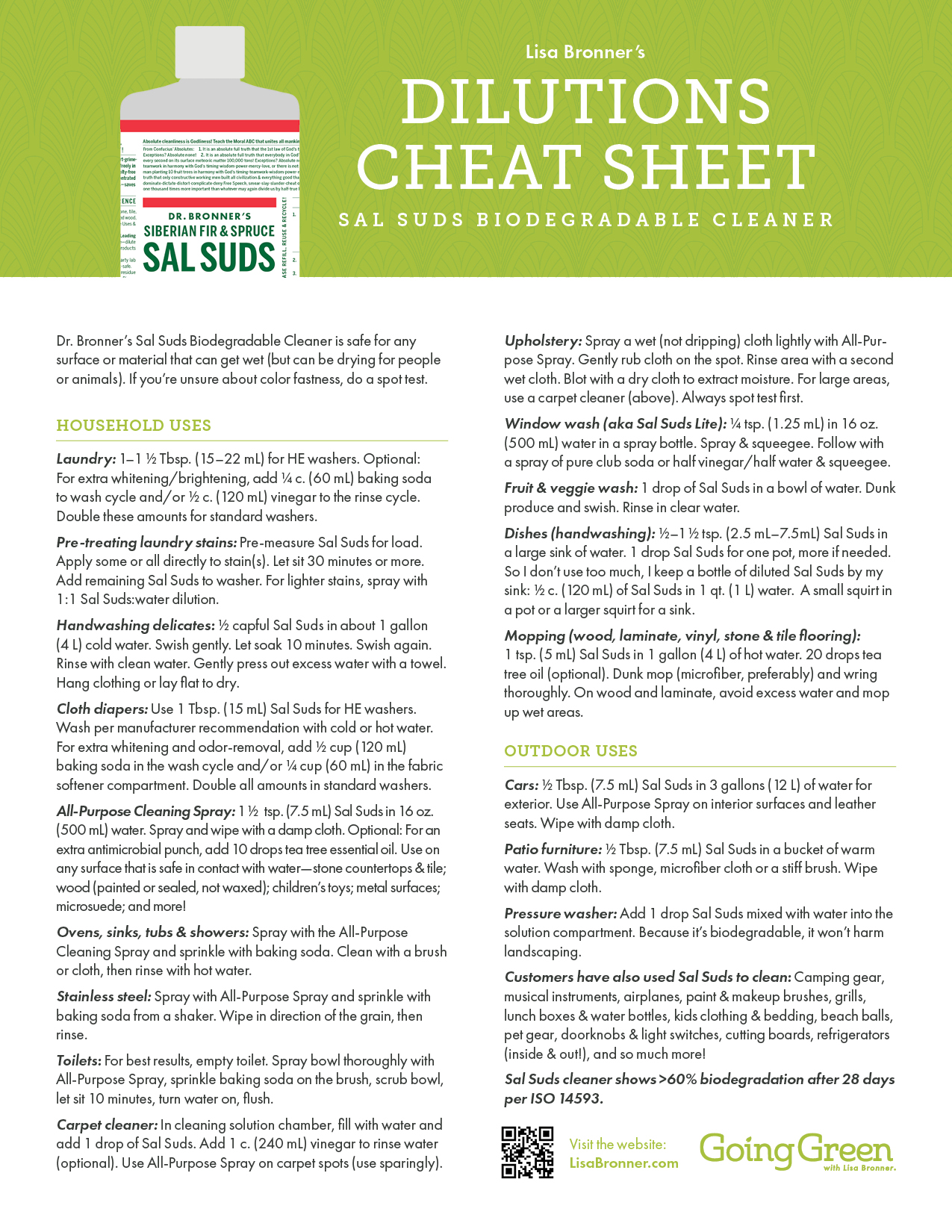
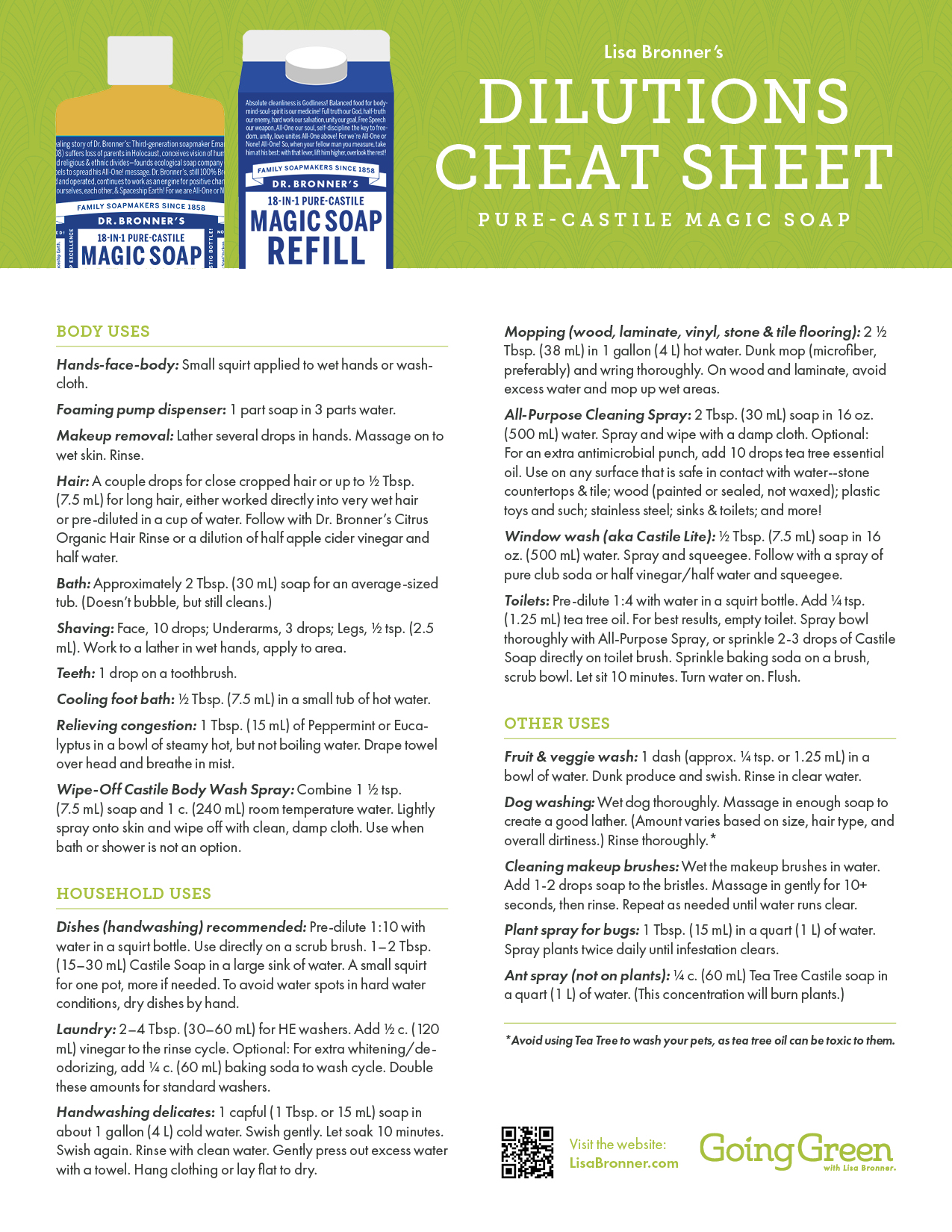

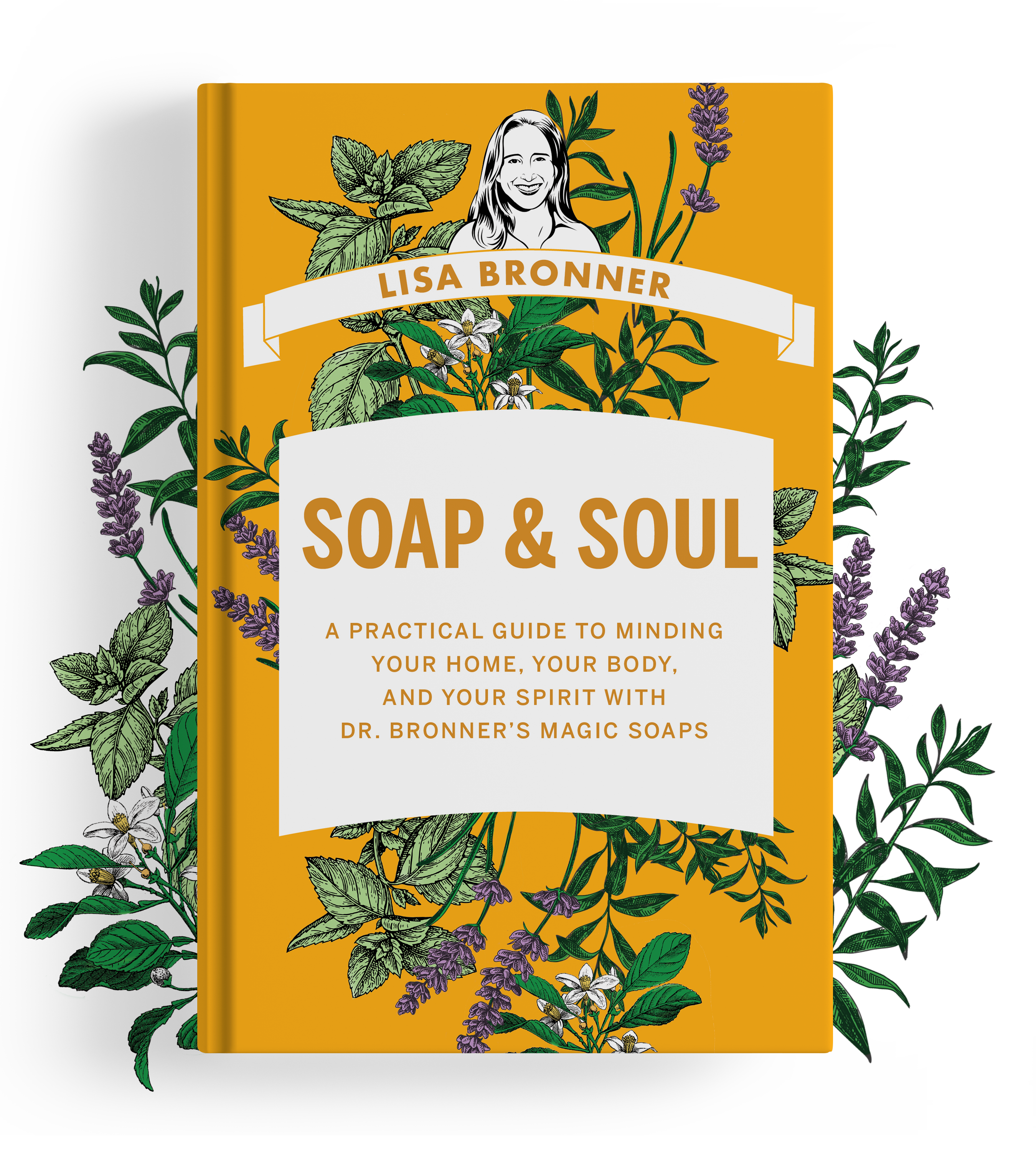
Great tips for cleaning ovens and stovetops with natural ingredients! The lemon and vinegar method is a classic, and the GIY All-Purpose Cleaning Spray with Dr. Bronner’s soap is a fantastic eco-friendly solution.
If you find that your oven needs professional attention after cleaning, I recommend checking out SmartFix Appliances for expert oven repairs. They offer reliable and efficient service to ensure your appliances stay in top condition.
Learn more about their services here: SmartFix Appliances Oven Repair (https://smartfixappliances.com/oven-repair/)
Thank you for these ideas especially for the oven. One reason it gets delayed was not wanting to use the store purchased cleaners/chemicals and it is self cleaning, but takes all day. I am definitely going to give the lemons a try. I agree with you that a clean kitchen encourages our cooking.
Would you recommend any of these processes for outdoor grill grates?
Hi Kelly – I’m so sorry for my delay in responding! Grill grates clean up well with a combo of baking soda and Sal Suds and a good soak. Make up a paste with baking soda, Sal Suds, and enough water to make it spreadable. Spread this on the grates. Fill a sink that they’d fit in with a couple inches of water (or use a bathtub if they don’t fit in your sink). Add 1/2 c. baking soda. Place the paste covered grates in the water and let sit 30 minutes. The scrub the grates with a stiff brush or scrubbie. Rinse well.
I have a lovely glass-top induction range, so that part is really easy to keep clean. The oven is a different story- my love for sheet-pan cooking means that the whole thing is liberally splattered with oil and food particles. I will not use the self-cleaning feature because I have heard that it can mess up the electronics in the range, and repairs are expensive. Mine does have a steam option, where you pour some water into the bottom and it locks and steams for 30 minutes. I might try that with lemon or vinegar water. I might also try your washcloth tip on That One Spot on my oven floor that doesn’t want to get clean.
I see that your other commenter also has an induction range. If you haven’t tried one, do it! They heat water faster than gas.
Thank you, Lisa! You have inspired me to be a green cleaning machine in my home. I can literally get anything clean at home with an all-purpose spray from any of the Castile soaps or Sal Suds + a steam cleaner. The crud cutting power of the spray is plenty, and the steam is just a sanitizing level of hot water to finish the job. Without the all-purpose spray, the steam cleaner doesn’t quite work as easily, but together I can avoid chemicals and live in a cleaner environment that smells so fresh. I love cleaning with Dr. Bronners soaps! I don’t have to fear cancer because of the work your company does.
thanks. I hate electric stoves, and now that America is becoming electric, these tips helps. I will try the lemon.
like you said the electric needs to be on the self clean 2hrs, 3hrs or 5hrs. 2hrs. does not work anymore. so now it is 3hrs. I hope the lemon will do the trick—a thousand thanks.
What perfect timing! We’re about to replace an oft-used, fading Dual-Fuel Kitchen Range with a brand-new, clean, All-Electric Induction Range. After much research, one Range stands out as our top choice–except for one thing: it has no “Self-cleaning” Oven. And so, your latest GIY Cleaning Tips are most welcome right now–especially your offering alternative kinds of “Self-cleaning” Ovens (where we, ourselves, do the cleaning–along with the help of Lemons, Vinegar, Heat–and, of course, Dr. Bronner’s)!
I’ve been looking forward to getting a new Kitchen Range for years, and I’m now also looking forward to cleaning it, even if it arrives without a “Self-cleaning” Oven (^~*) Thanks, Lisa!
Hi Cindy – You are very welcome! All the best with your new range and oven! I’m sure it will be the source of much deliciousness!
You’re going to love your induction cooktop…. I would be careful about vinegar on it though… I guess check with the manual. I just use my spray of sal suds and water. Since the cooktop doesn’t get hot you will find that you won’t have a problem with burned on food. Just wipe up any spills right away .